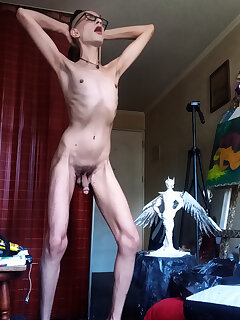Triptych
Although the cock, circumcised and marble-smooth, if flaccid, and hanging improbably from her lower belly, before a loose pouch filled with testicles, was undeniably beautiful, it, like the testes, seemed to be a jewel or an ornament more than an organ of the male sex, although, undoubtedly, they were such genitals. The apparent impossibility of such a beautifully feminine figure's sporting such manly equipment enhanced, rather than ruined, the eroticism of the work. The viewer found that his or her gaze returned again and again to the cock and balls, as to the face and breasts, of this otherwise feminine creature.
The panel on the right was an as-yet-bare canvas, which Russ had intended to call Woman. Together, the three panels, viewed from left to right, had been intended to show the complete transformation of a transsexual, from man to transwoman, to woman, but, now, Russ' masterpiece had been ruined by Sheila's last-minute decision to retain her male genitals.
Weeks of work, spent creating and revising his paintings to make them not only excellent but perfect, were wasted, thanks to Sheila's damnable indecisiveness. For the first time, Russ understood how truly frustrating, even maddening, Hamlet's irresolution must have been to his father's ghost and to the others whose lives had been affected by his mad variableness. Because of Hamlet's inability to decide and his refusal to act, by the end of the tragedy, not only his father, but his uncle, his mother, his beloved Ophelia, her father, her brother, and he himself also were dead. No one would die because of Sheila's change of mind (or heart), unless Russ thought, he killed her himself, but one of the world's great erotic paintings was irremediably lost, and this loss was worse than the deaths of a million men and women of flesh and blood, for art was eternal and flesh was but temporal. Sheila's decision not to go through with her sex-reassignment surgery had cost the world the erotic equivalent of Hieronymus Bosch's Garden of Earthly Delights, Roger van der Weyden's God of Pity or Earthly Vanity and Divine Salvation, or any other such inspired three-paneled painting. In refusing to undergo her total transformation, Sheila had sinned not only against herself, but she had sinned, also, against Russ, and, more importantly, against art itself.
Advertisment
- YuliyaW crossdresser
- 🫧 Bathroom Booty Bump & Bust
-
HA76The lustful cheongsam crossdresser is fucking her anal outside and squirting like crazy!
- Blaze Von Byrne & Riley Ivy
- sex with snow maiden
- Stunning Trans Beauty Bella Joie Cums While Taking Huge Dick
- Bruna rides the wave.
- Trans girl shooting cum all over herself
- Ultra Wet
- FerLaFemme - Ultra excitada Carne cruda de ano gordo
- THREE NYMPHO NYMPHS
- Kinky Massage From Hot Ladyboy
- Stunning Trans Beauty Bella Joie Cums While Taking Huge Dick
- CD With Massive Cock Strokes In Stockings
- ikeepthemcuming 52
- Tattooed black shemale receives a blow job
- Big Sensual Lips and Cum
- Insane huge dildo - Part 22
- Alyssa West
- The condom is too small (SPH)






































































